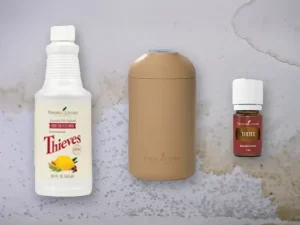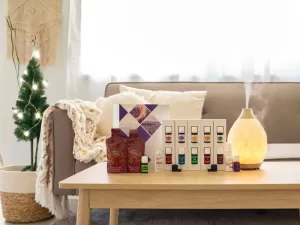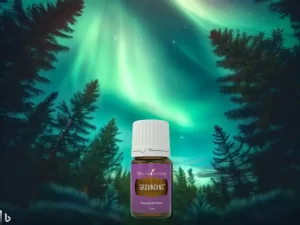I’ll be the first to admit that I was not a fan of Young Living Lavender essential oil. I didn’t mind the plant, but the essential oil reminded me of Grandma’s hankies. My mum used to say she was allergic to lavender and it gave her hayfever, so like a lot of people I just went on believing that to be the case. That was until I discovered that there was actually a difference.
There was a difference in species. A difference in quality based on how the essential oil is grown, harvested and distilled. A difference between 100% pure Lavandula angustifolia and what most shops, even health food shops were selling. Even a difference between the lavender used in soaps and perfumes with it’s synthetic linalols and lavandulol to make it smell like lavender. Once I knew better I could do better.
Most people don’t have the time to research what makes one essential oil brand different from another and they make buying decisions based on price or convenience at the time they are making a purchase. As a busy mum myself I understand that, so I have done the research for you. Here are 10 things you may not know about Lavender which may just change your opinion when it comes to which Lavender essential oil you buy and use with your family.
10 things you may not know about Young Living Lavender essential oil
- Lavender (Scientific Name: Lavandula) is one of the most fragrant and highly versatile essential oils in the world. Lavender comes from the same family as mint, although I’m sure you will agree it smells nothing like it. The name Lavender comes from the Latin verb, “lavare,” which means to wash. Even back in Elizabethan times people were bathing in lavender for both the beautiful aroma it gave their skin and because they believed it had cleansing properties. Today it’s is one of the most common scents used in products such as bath products, soaps, body lotions, hand creams and even shampoos. But, as you’ll soon see the lavender used in these products may not be all that it is cracked up to be.
- French lavender grows in France and Spanish lavender grows in Spain, right? Not necessarily! It seems like everyone wants to claim Lavender as their own. Old texts referred to Lavandula stoechas as French Lavender, whereas today they might call it Spanish lavender… or French Lavender. Lavandula dentata is also referred to as French Lavender… but it also grows in Spain. And, of course, English Lavender, also known as Common or True Lavender (Lavandula angustifolia) isn’t actually native to England! It grows… in France… and Spain… and now Utah and Tasmania. Phew! I hope I cleared that up for you…
- There are actually 47 known species of the lavender plant, with as many as 400 varieties across the world. Young Living Lavender essential oil is Lavandula angustifolia, although they also have some Lavandin (Lavandula x hybrida). That’s a hybrid plant developed by crossing lavender with spike lavender. Young Living use it in small amounts in some of their blends such as Purification and Release.
Know why Young Living Lavender essential oil is different from everyone else’s?
- Young Living grow their lavender in a different way to most other producers, who grow theirs from cuttings taken from mother plants. Growing lavender from cuttings is easier as lavender seeds are difficult to nurture, plus it also ensures you get plants that are identical in terms of plant size and flower colour. Other producers also grow hybrids such as Lavandin which grow into bigger bushes and yield 5-6 times more flowers. You’ve probably seen photos of ‘lavander’ fields with large plants all the same color? It’s probably Lavandin.
However, Young Living grow their Lavandula angustifolia from seeds. That’s why, If you visit a Young Living lavender farm you’ll notice that the bushes are not uniform in colour or size. It’s a deliberate choice. Gary Young wanted to grow plants from seeds so they adapted to the different growing conditions from year to year. He believed that lavender grown this way produced a better quality of essential oil with all the constituents present in the right range. When purchasing lavender essential oil, see if you can ask about its chemical formulation. Many factors (such as time of harvest can affect the composition of essential oils, and many companies even adulterate them with synthetic chemicals. Lavender should contain:- 25 to 38 percent linalool
- 25 to 45 percent linalyl acetate
- 0.3 to 1.5 percent cineole[i]
How to tell if you’re buying genuine Lavender essential oil
- Gary Young was concerned about the high camphene content in Lavandin which many essential oil companies sell off to unsuspecting consumers as “Lavender”[ii]. They are then surprised when the “Lavender” they bought doesn’t work in the way they thought it should or that they have a negative reaction. Oil cartels have discovered how to heat lavandin, flash off the camphene, and then add synthetic linalols and lavandulol to make it smell like lavender. These are the fragrance molecules that create the aroma that we recognise as lavender. I’ll just stick to the Lavandula angustifolia that Young Living sells thanks.
- Despite popular thinking, lavender doesn’t just come in blue or purple, but can come in shades of pink, white and even green. When I have visited the Young Living farms I have seen many white and pink flowered bushes in amongst the purple rows. This is one way you can tell if a farm grows their lavender from seed or cuttings.
Lavender has a LONG history of helping people stay well
- Lavender has quite the history lesson dating back over 2500 years ago when the Ancient Egyptians used it during the mummification process. Even Cleopatra was said to have used it to seduce Mark Antony. There is even a similar story for lavender as the one behind the Young Living Thieves essential oil blend. In the lavender story, seventh-century thieves washed in lavender after robbing graves and resisted the plague. Fast forward to the sixteenth-century, where reports said glove makers who perfumed their creations with lavender avoided catching cholera. In the 19th century, gypsy travellers sold bunches of lavender on the streets of London to bring people good luck and protect against ill fortune.[iii]
- Charles VI of France insisted his pillow always contain lavender so he could get a good night’s sleep. People still use lavender in pillows today. While humans find the scent of lavender calming, most bugs can’t stand it and will vacate an area where it is present. This makes it especially useful when planted as a border around the vegetable garden.
- Have you heard the children’s song “Lavender’s Blue”? Back in the Elizabethan times, when baths weren’t common practice, they used lavender to perfume clothes and bed linen. Women wore small lavender pouches in their cleavage to lure suitors – remember this lullaby:
“Lavender’s green dilly, dilly, lavender’s blue,
You must love me, dilly, dilly, ’cause I love you.”
Sprigs of lavender were even worn on clothing to prevent the effects of someone casting an evil eye on you.
Lavender for emotions
10. Aside from the many therapeutic benefits that Lavender essential oil has, Young Living Lavender essential oil also has benefits when it comes to emotional issues. Sixteenth-century English herbalist John Parkinson wrote that lavender was “especially good use for all griefes and paines of the head and brain.”[iv]
Young Living Lavender essential oil has been known to induce a sense of relaxation, mental clarity, and emotional stability. To reduce feelings of anxiousness, tension, sadness, and emotional imbalance. It enhances focus and inspires a sense of enlightenment. But I must stress that you really do need to buy the right lavender essential oil if you want to see any difference.
Frequencies and energy
Essential oils work subtly and over time when it comes to our emotions. They work with the bodies energies or what some call frequencies. If an essential oil has not been grown, harvested and distilled in the right way or it has been adulterated it wont have the right frequency to do it’s job.
Gary Young likened all the constituents in an essential oil to musical notes. Each note had to be in perfect balance with the other notes. If one of the notes is even slightly off the instrument will sound out of tune. This is exactly what happens when you use inferior essential oils. They don’t have the same natural frequencies as the body and the body finds them irritating. All the notes must be present for them to work in harmony with the body.
You can’t just extract one constituent found in lavender essential oil and think it will have the same effect on the body as the 100% pure lavender essential oil or even the plant does. This is exactly why a lot of pharmaceutical drugs have side effects. They have extracted individual constituents and expect them to work in the same way the whole plant or essential oil does but the body often finds this irritating. Give your body what it needs with an entire orchestra of notes playing perfectly in tune at a frequency that is healing or can even lift you up.
Learn more about Young Living Lavender Essential Oil

Young Living Lavender Essential Oil Infused Products
Young Living Lavender Bath & Shower Gel:
Infused with pure Lavender oil, this luxurious bath & shower gel is free of harsh chemicals and synthetic preservatives and contains plant-based ingredients such as coconut oil and star anise, making it pure enough for the gentlest of skin.
Savvy Minerals by Young Living Lengthening Mascara:
Farewell to falsies, we’re going natural! Infused with Young Living Lavender essential oil from our farm in Simiane-la-Rotonde, France as well as arginine, buildable natural plant fibres and carnauba wax, our clean, richly pigmented formula glides on without unwanted clumps or flakes to lengthen and define lashes.
Young Living Seedlings Calm 5 ml:
Dreamland is only a few drops away with this soothing, gentle scent. Formulated with Young Living Lavender essential oil, Coriander, Bergamot, Ylang Ylang & Geranium essential oils, this special blend can help the whole family unwind together. Diffuse this near your bed or child’s bed for a restful night’s sleep.
Young Living Lavender Essential Oil Calming Bath Bombs:
Unwind after a long day with the calming aroma of Lavender. These natural bath bombs are filled with nourishing ingredients such as coconut oil and sweet almond oil with no unwanted additives. That means they’re not only fun and relaxing—they also leave skin soft, smooth and moisturised.
Young Living Lavender Essential Oil 5 ml:
Young Living has three farms that grow Lavender, located in Utah, Idaho and France. Steam distilled from the flowering tops of the plant; it takes 2.5m2 of lavender plants to make one 15ml bottle of Lavender essential oil! With its many uses – fresh, floral, clean and calm, this versatile oil can be used from skin care products to relaxation and even added to your favourite food or drinks!
[i] https://www.healthline.com/health/lavender-history-plant-care-types#what-about-love
[ii] https://www.dgaryyoung.com/blog/2011/are-you-buying-lavender-or-lavandin/
[iii] https://www.healthline.com/health/lavender-history-plant-care-types#what-about-love
[iv] https://www.healthline.com/health/lavender-history-plant-care-types#what-about-love










 Subscribe to Hot Oily Mumma
Subscribe to Hot Oily Mumma